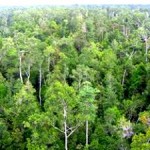
Animal Waste
There are a wide range of animal wastes that can be used as sources of biomass energy. The most common sources are animal and poultry manures. In the past this waste was recovered and sold as a fertilizer or simply spread onto agricultural land, but the introduction of tighter environmental controls on odour and water pollution means that some form of waste management is now required, which provides further incentives for waste-to-energy conversion.
The most attractive method of converting these waste materials to useful form is anaerobic digestion which gives biogas that can be used as a fuel for internal combustion engines, to generate electricity from small gas turbines, burnt directly for cooking, or for space and water heating.

Forestry Residues
Forestry residues are generated by operations such as thinning of plantations, clearing for logging roads, extracting stem-wood for pulp and timber, and natural attrition. Harvesting may occur as thinning in young stands, or cutting in older stands for timber or pulp that also yields tops and branches usable for biomass energy. Harvesting operations usually remove only 25 to 50 percent of the volume, leaving the residues available as biomass for energy.
Stands damaged by insects, disease or fire are additional sources of biomass. Forest residues normally have low density and fuel values that keep transport costs high, and so it is economical to reduce the biomass density in the forest itself.

Wood Wastes
Wood processing industries primarily include sawmilling, plywood, wood panel, furniture, building component, flooring, particle board, moulding, jointing and craft industries. Wood wastes generally are concentrated at the processing factories, e.g. plywood mills and sawmills. The amount of waste generated from wood processing industries varies from one type industry to another depending on the form of raw material and finished product.
Generally, the waste from wood industries such as saw millings and plywood, veneer and others are sawdust, off-cuts, trims and shavings. Sawdust arise from cutting, sizing, re-sawing, edging, while trims and shaving are the consequence of trimming and smoothing of wood. In general, processing of 1,000 kg of wood in the furniture industries will lead to waste generation of almost half (45 %), i.e. 450 kg of wood. Similarly, when processing 1,000 kg of wood in sawmill, the waste will amount to more than half (52 %), i.e. 520 kg wood.

Industrial Wastes
The food industry produces a large number of residues and by-products that can be used as biomass energy sources. These waste materials are generated from all sectors of the food industry with everything from meat production to confectionery producing waste that can be utilised as an energy source.
Solid wastes include peelings and scraps from fruit and vegetables, food that does not meet quality control standards, pulp and fibre from sugar and starch extraction, filter sludges and coffee grounds. These wastes are usually disposed of in landfill dumps.
Liquid wastes are generated by washing meat, fruit and vegetables, blanching fruit and vegetables, pre-cooking meats, poultry and fish, cleaning and processing operations as well as wine making.
These waste waters contain sugars, starches and other dissolved and solid organic matter. The potential exists for these industrial wastes to be anaerobically digested to produce biogas, or fermented to produce ethanol, and several commercial examples of waste-to-energy conversion already exist.
Pulp and paper industry is considered to be one of the highly polluting industries and consumes large amount of energy and water in various unit operations. The wastewater discharged by this industry is highly heterogeneous as it contains compounds from wood or other raw materials, processed chemicals as well as compound formed during processing. Black liquor can be judiciously utilized for production of biogas using anaerobic UASB technology.

Municipal Solid Wastes & Sewage
Millions of tonnes of household waste are collected each year with the vast majority disposed of in open fields. The biomass resource in MSW comprises the putrescibles, paper and plastic and averages 80% of the total MSW collected. Municipal solid waste can be converted into energy by direct combustion, or by natural anaerobic digestion in the engineered landfill. At the landfill sites the gas produced by the natural decomposition of MSW (approximately 50% methane and 50% carbon dioxide) is collected from the stored material and scrubbed and cleaned before feeding into internal combustion engines or gas turbines to generate heat and power. The organic fraction of MSW can be anaerobically stabilized in a high-rate digester to obtain biogas for electricity or steam generation.
Sewage is a source of biomass energy that is very similar to the other animal wastes. Energy can be extracted from sewage using anaerobic digestion to produce biogas. The sewage sludge that remains can be incinerated or undergo pyrolysis to produce more biogas.












